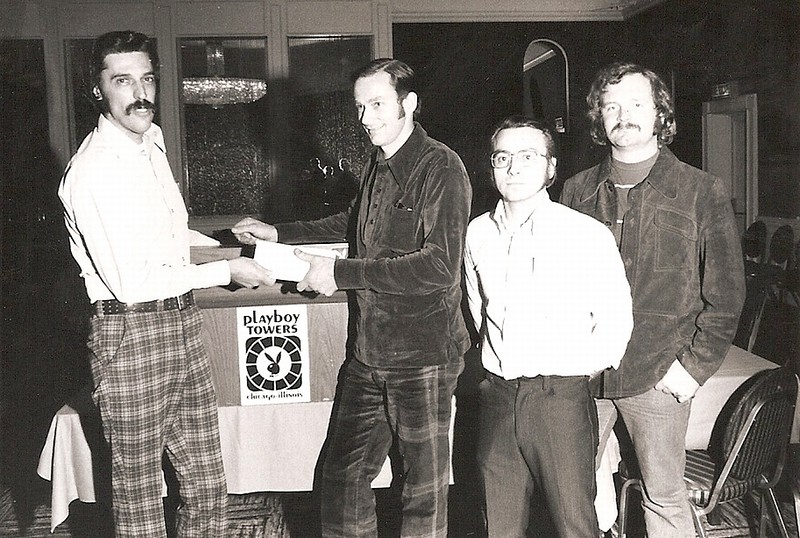Jon Asher
Nitro Member
- Joined
- Jul 10, 2006
- Messages
- 198
- Location
- New Mexico
Ron Pellegrini 1935-2018
Although Ron Pelligrini’s name isn’t known by most of today’s drag racing participants, fans or members of the media, from the 50s and well into the 80s he played a major role in the sport. From competing in some of the most famous cars the sport has ever seen to becoming one of the most important aftermarket manufacturers in the history of Funny Car racing to his involvement in running actual races, Pellegrini has done it all.
In the early 50s Pellegrini drag raced on the dirt track (not a misprint) at Halfday, Illinois, and built his first Oldsmobile-powered dragster in 1954. A year later, still drag racing on dirt at Oswego, Illinois he set the top time of the year, but more relevant was his work with Jim Lemonis of ATAA, which would ultimately be folded into the then-new NHRA. Pellegrini also worked with Al Fosdick of Fosdick Timing Equipment, installing and maintaining the timers at numerous Midwest tracks.
In 1960 Pellegrini purchased Tommy Ivo’s side-by-side twin engined dragster and followed that up by purchasing and running Ivo’s four-engined car the next year. Pellegrini would become the first driver to appear at the U.S. Nationals in an exhibition car when he drove the car at Indy in ’61 and ’62.
By 1964 Pellegrini had switched to a Ford, fielding three factory-backed Thunderbolts through Hawkinson Ford in Oak Lawn, Illinois. The following year Pellegrini pitched – and was rejected by – Ford Motor Company on a tube-chassied Funny Car, which Ford, at the time, didn’t feel was feasible. Since he had pre-booked the car for match races he was forced to buy the infamous Dennison, Arlasky & Knox AA/Fuel Altered, to which he affixed a one-piece fiberglass Mustang body that he built himself.
Pellegrini’s blown Mustang was the first “real” Funny Car that wasn’t a factory-produced, altered wheelbase machine.
That same year he opened Fiberglass Ltd., which would become the premier supplier of Funny Car bodies for the remainder of the 60s and well into the 70s. If you raced or watched Funny Cars the odds were you were seeing cars carrying Fiberglass Ltd. shells. Pellegrini did all of the aerodynamic development on the bodies himself, and ultimately ended up supplying hardware for the factory-backed match racers competing for Ford, Dodge, Plymouth and General Motors. Racers from Arnie “The Farmer” Beswick to Mr. Norm’s Grand-Spaulding Dodge entries to virtually every “name” racer of the era ran Fiberglass Ltd. bodies.
As one of the original members of the Midwest UDRA operation Pellegrini was the overseer of a number of professional racing circuits that competed on a hired-in basis all across the region in 1966. His hands-on professionalism resulted in happy track operators and even happier fans who gladly paid top dollar to witness nitro-fueled Funny Cars, alcohol-fueled Funny Cars, Top Fuel dragsters, Supercharged Gassers and cars that would eventually be called “Pro Stock.” On any given weekend Pellegrini’s charges might be appearing at a half dozen or more facilities, yet he managed it all without a hitch – and this was long before cell phones!
A year later he opened Automotive Research & Engineering in an effort to offer racers one-stop shopping for complete operations. Teaming Fiberglas Ltd. with R&B Automotive of Kenosha, Wisconsin, International Drag Racing Hall of Fame and Motorsports Hall of Fame member John Buttera and his partner, Denis Rollain fabricated the chassis while Pellegrini supplied the bodies. Among those who took advantage of the program were Bobby Woods and Don Gay. Hall of Fame member Don Schumacher’s first Dodge Charger Funny Car was a product of this same operation.
In ’67 Pellegrini built and drove the first Buick-bodied Funny Car (with a Logghe Stamping Company chassis) and a year later came out with another Buick, this one on a Romeo Palamides frame. Built to Pellegrini’s specifications, it was the first F/C to have a narrow frame and rearend.
By 1973 Pellegrini had folded Fiberglass Ltd. into his Uni-Sun sunroof operation, but he was still racing, and from 1975 to 1980 put together and ran the International Funny Car Association. He also owned and fielded both alcohol dragsters and Funny Cars until 1983, when he retired from active competition.
So those are the nuts and bolts, and as important as they are in terms of history, they fall far short of saying who Pellegrini was. He was a friend, mentor and advisor to dozens of 60s and 70s racers, track operators and journalists, myself proudly included. When this tall, thin dark-haired man spoke, people listened, because his words were often prophetic. Fifty years ago he foretold what drag racing would become, and while some belittled his predictions, they’ve more or less come true. Decades before 18-wheelers jammed the nation’s tracks he spoke of their coming, just as he voiced his concerns about the need for a variety of car brands to be involved so that every fan might have something to root for. But his outspokenness often came at a price. Many racing officials, the ones some writers refer to has the “High Sheriffs,” thought little of his thoughtfulness, and that hurt him.
Despite his being absent from the races for some time he remained in close contact with many of his older friends who were involved, and from voracious reading and an innate ability to discern what was really going by watching the televised events he continued to have an authoritative picture of what drag racing is today.
Survived by his two daughters, Denise and Deborah, and five grandchildren, Pellegrini also leaves behind his constant companion and confidante of 54 years, Adele Coyle. He was 82 when he died of natural causes, and per his wishes, there will be no funeral or formal remembrance. – Jon Asher

 Untitled
Untitled